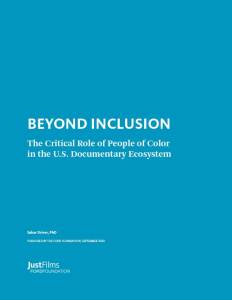The Challenge
It is in many respects an ascendant time for documentary film as an artistic, commercial and social justice medium. Documentary film is used by artists and advocates to advance social change, it can be a platform to shape or contest cultural and political power, and to create or dismantle cultural narratives and form worldviews and values.
At the same time, inequality within the industry persists and the individuals and communities who are often the subject of documentary storytelling do not receive the benefits and cultural power accrued from a project’s success. In the U.S., individuals of color and those intersected with gender, class and disability are too often not the authors or decision makers of films that tell the story of their communities. They are excluded from the full participation in social justice storytelling and too often do not benefit directly from its transformative potential.
Documentary organizations led by and serving communities of color have worked to address this challenge since the 1970s, through artist support, mentorship, funding and distribution. While their work has incubated vital films and served as a key talent development and leadership pipeline for the documentary field, these organizations have been chronically undercapitalized. Their work to build a more equitable documentary sector and by turn a more inclusive and democratic society has not been fully realized.
Today, narratives authored by filmmakers of color and leadership from a non-dominant perspective are critical to addressing the intersectional challenges facing the documentary field and society at large. Significant philanthropic investment in documentary organizations led by and serving communities of color is crucially needed, to build a more inclusive sector and help reshape social narratives that reinforce inequality.
What’s in The Report
Beyond Inclusion is researched and written by Sahar Driver, PhD. It outlines the relationship between documentary and social change, provides a critical overview of nonfiction film organizations led by and serving communities of color in the US, their impact in shaping a more equitable documentary sector, and how they advance non-fiction social justice filmmaking. It makes recommendations to funders and stakeholders on why and how these efforts should be resourced at this time.
Drawing from a dataset of nearly 200 organizations, Beyond Inclusion details the key functions and activities of these organizations today, which range from supporting the artists (providing equipment and training, resources, and networking opportunities), to distributing the works of filmmakers of color to audiences of color, to funding.
The report’s recommendations to funders include investing in POC-led organizations with clear plans and commitments to nurture POC authorship, audiences, and careers as well as film production models and practices with a higher standard of ethics and accountability in the creation, funding and distribution of documentaries.
The report concludes that a generational investment in POC infrastructure is necessary to both shore up legacy organizations that have worked with minimal resources for decades as well as dynamic new organizations and networks that have emerged in the last ten years. These players constitute a powerful ecosystem that—if properly resourced—can be a significant force in transforming the documentary landscape toward one that is more inclusive, ethically grounded and sustainable, and that ultimately is a more powerful force for social change.
